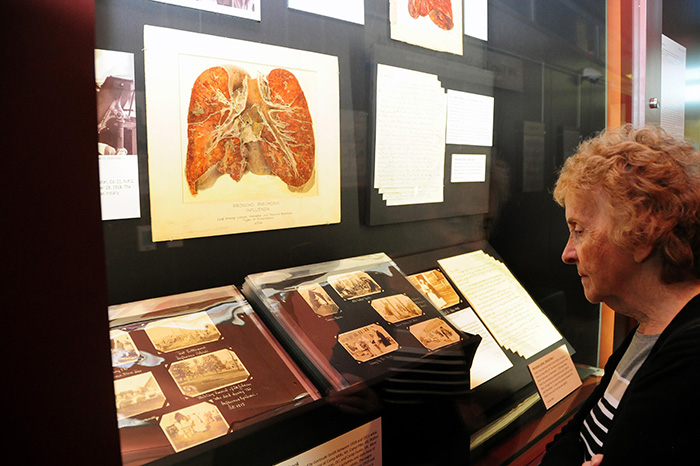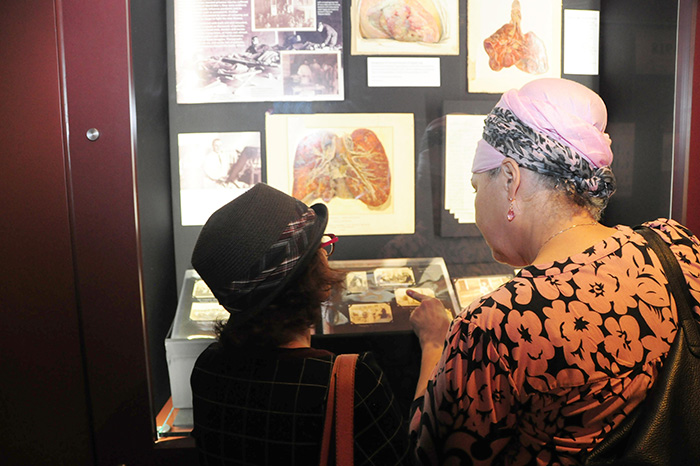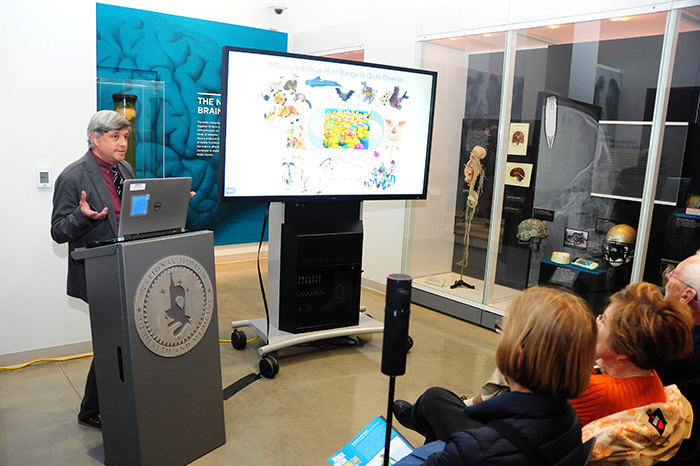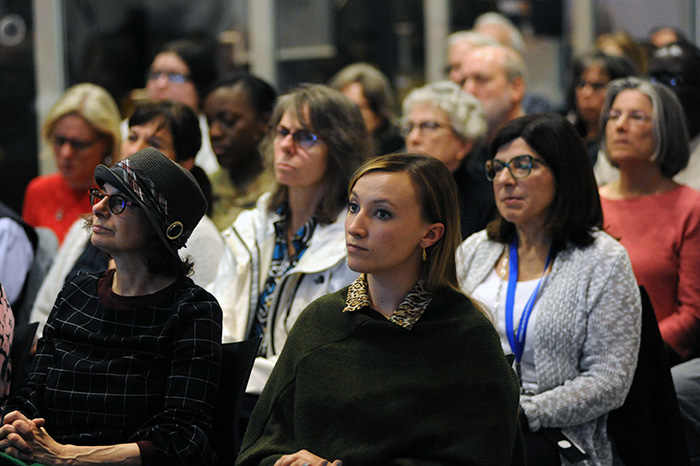Centenary of the 1918 Influenza: Pathologist Is Working To Create New Vaccines
By Lauren Bigge
NMHM Public Affairs Coordinator
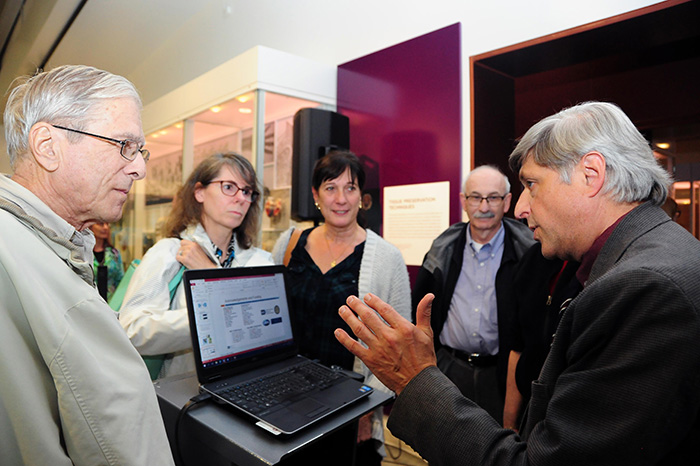
Jeffery Taubenberger, M.D., Ph.D., pathologist from the National Institutes of Health, answers audience members' questions following his Oct. 23, 2018 Medical Museum Science Café presentation titled "On the Centenary of the 1918 Influenza: Lessons from the Past and Planning for the Future" at the National Museum of Health and Medicine in Silver Spring, Md. (Photo by Mike Walters, Walter Reed Army Institute of Research/Released)
The National Institutes of Health's pathologist Jeffery K. Taubenberger, M.D., Ph.D., is renowned for leading a team in identifying and reconstructing the influenza virus that killed 675,000 people in the United States during the 1918-1919 global pandemic. He spoke about his team's work as well as preparing for future pandemics to the Medical Museum Science Café audience at the National Museum of Health and Medicine (NMHM) on Oct. 23.
From 1995 to 2006, Dr. Taubenberger's team decoded the influenza's genetic sequence using fragments of viral RNA preserved in approximately 12 autopsy samples from American soldiers, as well as samples from an Inuit female buried in the permafrost in Alaska, and autopsy samples from the United Kingdom. Those soldiers' autopsy samples were stored at the Armed Forces Institute of Pathology (AFIP) – the parent organization of NMHM - until AFIP's closure in 2011. He was the head of AFIP's molecular pathology division, and recollected that "we had this crazy idea that we could try to find fragments of RNA of the 1918 virus in the preserved autopsy tissues."
Dr. Taubenberger called the 1918 influenza the "mother of all flus," noting that all human flu viruses since the pandemic originated from that H1N1 virus. He pointed out that the U.S. military lost 43,000 service members to influenza out of the more than 100,000 U.S. service member casualties during World War I, but at the time the concept of a virus as an infectious agent was new. Medical personnel called influenza the "plague" in such locations as Camp Devens near Boston, Massachusetts. On Sept. 7, 1918, a single soldier went into the hospital with symptoms. Within three weeks, there were 12,604 cases in the hospital. "At the end of the outbreak, one-third of the camp became ill and over 800 young, healthy 18-25-year-old men died of an influenza pneumonia," Dr. Taubenberger said.
Without vaccines, anti-viral medication, or antibiotics, medical personnel at Camp Devens and elsewhere were unable to stop the influenza's progression. Patients died with fluid-filled lungs, blood clots throughout their lungs, and secondary untreated bacterial bronchopneumonia. "The impact was so great that it caused life expectancy in the United States to drop by about a dozen years in 1918," he said. The total number of global deaths in the nine months of the pandemic was estimated at 50-100 million.
Such staggering statistics are part of a special NMHM exhibit titled, "100 Years Ago: October-November 1918; The End of World War I, and the World Wide Flu Pandemic" for the centenary of the 1918 influenza. The exhibit on display through December 2018 includes anatomical specimens, medical illustrations, letters, and photographs from NMHM's collections to educate visitors about the personal and factual aspects of the historic pandemic's effects on society. Dr. Taubenberger's presentation complemented the exhibit.
He explained that influenza is an RNA virus and does not have the ability to correct errors. It mutates frequently because it has a very high error rate. "Every time the virus replicates, it makes a number of mutations," he said. "The virus lives in a huge pool of viruses, where every virus has its own set of mutations. Occasionally, a mutation may be beneficial to the virus. The virus uses this very sloppy genetic lifestyle to escape from things and to select for new environments, so it's very opportunistic."
Influenza is ultimately a gastrointestinal bird virus. A host for the virus can cause infections in wild mammals and humans. "They have the ability to cause infections, and then develop mutations and adaptations that allow them to be viruses of a new species," Dr. Taubenberger said.
The threat from mutations means annual vaccinations are critical - yet they are not adequate. "The 1918 is very pathogenic in a way that's very unusual," Dr. Taubenberger said. He noted that the Centers for Disease Control estimated that 50-80,000 individuals in the United States died from seasonal influenza in 2017. The H3N2 and H1N1 influenza viruses continue circulating. With that in mind, Dr. Taubenberger's lab is working on a couple of ideas for a universal vaccine, with the intent to provide broader and more lasting protection. One is to make a vaccine using a mixture of proteins from bird viruses of different subtypes. The vaccine "challenges" the host body with every flu strain that causes disease, and so far he and colleagues are seeing 100 percent flu protection in animals.
Studying the human response next is critical in order to design a rational universal vaccine. The Influenza Challenge Study involves healthy adult volunteers participating in in-patient studies for a minimum of nine days. Influenza Challenge models are ideal for evaluating new vaccines and drugs, he explained. "We're going to start initial Phase I safety tests in humans in about a year at the NIH Clinical Center," Dr. Taubenberger said.
NMHM's Medical Museum Science Cafés provide forums for informal talks that connect the mission of the Department of Defense museum with the public. NMHM was founded as the Army Medical Museum in 1862 and is a division of the Defense Health Agency Research and Development Directorate. For more information on upcoming events, call 301-319-3303 or visit www.medicalmuseum.mil.
